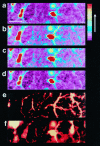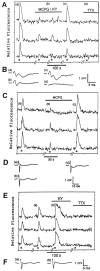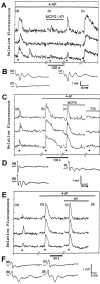Hippocampal astrocytes in situ respond to glutamate released from synaptic terminals
- PMID: 8756437
- PMCID: PMC6579292
- DOI: 10.1523/JNEUROSCI.16-16-05073.1996
Hippocampal astrocytes in situ respond to glutamate released from synaptic terminals
Abstract
A long-standing question in neurobiology is whether astrocytes respond to the neuronal release of neurotransmitters in vivo. To address this question, acutely isolated hippocampal slices were loaded with the calcium-sensitive dye Calcium Green-1 and the responses of the astrocytes to electrical stimulation of the Schaffer collaterals were monitored by confocal microscopy. To confirm that the responsive cells were astrocytes, the slices were immunostained for the astrocytic marker glial fibrillary acidic protein. Stimulation of the Schaffer collaterals (50 Hz, 2 sec) resulted in increases in the concentration of intracellular calcium ([Ca2+]i) in the astrocytes located in the stratum radiatum of CA1. The astrocytic responses were blocked by the sodium channel blocker tetrodotoxin, the voltage-dependent calcium channel blocker omega-conotoxin-MVIIC, and the selective metabotropic glutamate receptor antagonist alpha-methyl-4-carboxyphenylglycine (MCPG). These results suggest that the astrocytic responses were induced by stimulation of metabotropic glutamate receptors on the astrocytes by neuronally released glutamate. The astrocytic responses to neuronal stimulation were enhanced in the presence of the K+ channel antagonist 4-aminopyridine (4-AP). Inhibition of the astrocytic responses in the presence of 4-AP required the presence of both MCPG and the ionotropic glutamate receptor antagonist kynurenic acid. These results suggest that higher levels of neuronal activity result in stimulation of both metabotropic and ionotropic glutamate receptors on the astrocytes. Overall, the results indicate that hippocampal astrocytes in situ are able to respond to the neuronal release of the neurotransmitter glutamate with increases in [Ca2+]i.
Figures






References
-
- Aoki C, Pickel VM. Ultrastructural relations between β-adrenergic receptors and catecholaminergic neurons. Brain Res Bull. 1992;29:257–263. - PubMed
-
- Aoki C, Joh TH, Pickel VM. Ultrastructural localization of β-adrenergic receptor-like immunoreactivity in the cortex and neostriatum of rat brain. Brain Res. 1987;437:264–282. - PubMed
-
- Bashir ZI, Bortolotto ZA, Davies CH, Berretta N, Irving AJ, Seal AJ, Henley JM, Jane DE, Watkins JC, Collingridge GL. Induction of LTP in the hippocampus needs synaptic activation of glutamate metabotropic receptors. Nature. 1993;363:347–350. - PubMed
-
- Buijs RM, van Vulpen EHS, Geffard M. Ultrastructural localization of GABA in the supraoptic nucleus and neural lobe. Neuroscience. 1987;20:347–355. - PubMed
Publication types
MeSH terms
Substances
Grants and funding
LinkOut - more resources
Full Text Sources
Other Literature Sources
Miscellaneous
